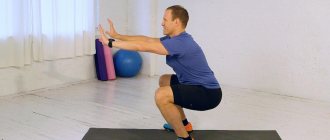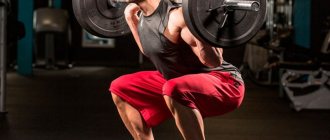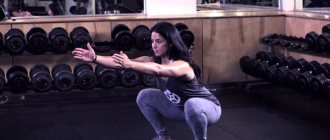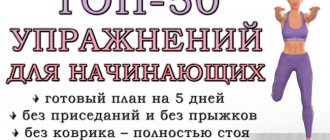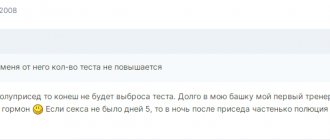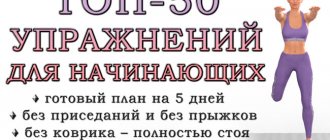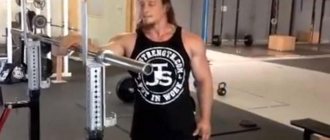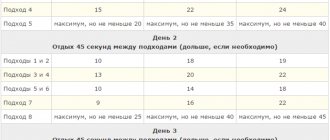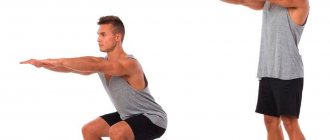Do you dream of creating toned legs and buttocks at home? We invite you to try the four-week squat challenge, which includes 24 squat variations and 7,000 squats in a month! Do the exercises every day from Monday to Saturday, and on the last day of the weekly challenge, give yourself a well-deserved break from training.
Challenge squats: how to do them
Squats are one of the best exercises at home that allow you to work your quadriceps, gluteal, calf, hamstring, abdominal and back muscles. We offer you 24 variations of squats, which are distributed over 6 days from Monday to Saturday. In just the four-week plan, you'll complete 7,000 squats.
Number of squats:
- First week: 1000 squats
- Second week: 1500 squats
- Week three: 2000 squats
- Week four: 2500 squats
Before you start practicing, be sure to read the article: How to squat correctly.
How to change the load:
- If you are a beginner, you can reduce the number of repetitions or sets by 2 times.
- If you are an advanced practitioner, you can use dumbbells, fitness bands or leg weights to increase the load.
For people with joint problems, diseases of the cardiovascular system, and varicose veins, the challenge is not recommended. For other restrictions on physical activity, it is better to consult a specialist.
What results will you get after a month of squats:
- pump up and round your buttocks;
- get rid of cellulite and breeches;
- reduce fat deposits on the legs;
- make your thighs toned and elastic;
- improve overall body endurance;
- reduce fat folds on the stomach and sides.
So, you will perform 4 types of squats per day, 6 days a week. At the end of the week, you will have one day of rest, then you will return to the starting plan. With each new week the number of repetitions will increase. You only need to follow the pre-made plan, performing the specified number of repetitions.
- Monday: One-two squats, side swing squats, heel touch squats, narrow position plies.
- Tuesday: Pulse Sumo Squat, Cross Lunge Squat, Jump Twist Squat, Pulse Fly Squat.
- Wednesday: Sumo Squat Jumps, Calf Raise Squats, Front Swing Squats, Narrow Side Step Squats.
- Thursday: Jump squats, plie squats, crunch squats, leg abduction pulse squats.
- Friday: Side step squats, Sumo squats with calf raises, Pulse jump squats, Single leg calf squats.
- Saturday: Plie jump squat, Back squat, Kneeling squat, Circle squat.
How to do the exercises:
- Before training, do a warm-up, and after training, stretch (warm-up and cool-down exercises).
- If you perform the challenge after your main workout, then you do not need to warm up additionally.
- Perform the number of repetitions below according to the week.
- Between sets, stop to rest for 30-60 seconds, depending on the difficulty of the exercise.
- Between exercises, take 1-3 minutes of rest depending on the difficulty of the exercise and your physical fitness.
- You can divide the challenge into two approaches: morning and evening.
What to combine challenge squats with:
- Plank-based workout for stomach and back
- Workout with dumbbells for slender arms
- Cardio workout with jumping jacks to burn fat
- Cardio workout without jumping to burn fat
- Inner thigh workout
- Ab workout on the floor
- HIIT workout for slimming legs
- HIIT workout for belly fat loss
Attention!
If you have health problems, such activities are strictly not recommended for you. Be examined by your doctor first, who will recommend a different way of training. There are the following contraindications:
- increased intracranial pressure;
- spinal or joint injuries;
- hernia;
- pregnancy;
- scoliosis and other spinal deformities.
Squat Challenge: Monday
One-two squats
The starting position of the exercise is to have your feet shoulder-width apart, your hands clasped in front of your chest, your back straight, your stomach pulled in, your head looking forward. From this position, perform a half squat for a count of “one”, then a full squat for a count of “two” until your thighs are parallel to the floor. Make sure that your knees are positioned strictly above your feet and do not go ahead of your toes. Return to the starting position in the same way one or two times.
How much to do:
- First week: 15 squats in 3 sets.
- Second week: 18 squats in 4 sets.
- Third week: 18 squats in 5 sets.
- Week four: 23 squats in 5 sets.
Side swing squats
To perform this type of squats at home, place your feet shoulder-width apart, keep your hands clasped in front of your chest, straighten your back and pull in your stomach. Perform a squat until your thighs are parallel to the floor. Then, as you rise, swing your straight leg to the side. This exercise uses the inner thigh, which is problematic for many, and also pumps up the buttocks and other leg muscles. Perform the exercise first on one leg, then on the other.
How much to do:
- First week: 20 squats, first on one side, then 20 squats on the other side.
- Second week: 30 squats, first on one side, then 30 squats on the other side.
- Third week: 20 squats, first on one side, then 20 squats on the other side, repeat in two sets.
- Week four: 30 squats, first on one side, then 30 squats on the other side, repeat in two sets.
Squats with heel touching buttocks
This exercise is performed from a position with your legs spread wider than your shoulders and your arms folded in front of your chest. First, do a shallow squat. Next, as you straighten, touch your heel to your buttock in the opposite direction. Return to the squat position and repeat the exercise on the other leg. Make sure that the heel of the supporting leg does not leave the floor. This type of squat is very effective for fat burning, has a beneficial effect on the muscle tone of the legs and buttocks, and improves coordination.
How much to do:
- First week: 30 squats (15 leg curls), repeat in two sets.
- Second week: 30 squats (15 leg curls), repeat in three sets.
- Third week: 30 squats (15 leg curls), repeat in four sets.
- Week four: 30 squats (15 leg curls), repeat in four sets.
Plie in a narrow position
During the exercise, the weight must be transferred to the toes. Place your feet together, your heels together, your toes apart, your knees pointing diagonally, your gaze directed forward. Make sure your back remains level and tighten your abs. From this position, perform a squat with your heels off the floor. The exercise helps to tighten the buttocks and get rid of problem areas on the inner and outer thighs. To simplify the exercise, you can hold on to the chair with your hand.
How much to do:
- First week: 10 squats in 2 sets.
- Second week: 10 squats in 3 sets.
- Third week: 10 squats in 4 sets.
- Week four: 15 squats in 4 sets.
Equipment
During class, leave your slippers aside. Find athletic shoes that keep your feet planted on the ground. Clothes should not restrict movement or be too loose. Choose a material so that it absorbs sweat well and the surface of the body breathes.
Use weights as an additional load to lose weight. Dumbbells, barbells, sand bottles or heavy backpacks work well for daily exercise. The weight you choose should match your body's capabilities. You can also optionally use electronic devices that will track your pulse, count the number of calories burned and approaches completed.
Squat Challenge: Tuesday
Sumo squat with pulsation
The starting position of the exercise is as for wide squats. Place your feet wider than your hips, turn your toes diagonally, and keep your heels on the floor. Keep your hands clasped in front of your chest, your back straight. Lower yourself into a squat position until your thighs are parallel to the floor, with your body moving forward. At the lowest point, perform 3-4 pulsating movements with a small amplitude. Sumo squats with pulsation effectively work on the gluteal and thigh muscles; this type of squats is suitable for both weight loss and muscle tone.
How much to do:
- First week: 15 squats in 3 sets.
- Second week: 15 squats in 4 sets.
- Third week: 15 squats in 5 sets.
- Week four: 20 squats in 4 sets.
Cross Squat
Perform a squat until your thighs are parallel to the floor, then through the rise, do a cross lunge back, resting on your toes, without touching your knee to the floor. Don't lift your foot too far. Perform alternately on both sides. This type of squats is useful for losing weight in the inner and outer thighs and maintaining the tone of the gluteal muscles.
How much to do:
- First week: 20 squats (10 lunges on each side), repeat in two sets.
- Second week: 20 squats (10 lunges on each side), repeat in three sets.
- Week three: 26 squats (13 lunges on each side), repeat in four sets.
- Week four: 30 squats (15 lunges on each side), repeat for four sets.
Jump Twist Squats
Perform a classic squat, then jump up sharply and rotate your pelvis to the side. Land on your toes, which point diagonally in one direction. The body does not move, only the lower part of the body turns. High intensity exercise will help you lose weight in the abdomen and waist, pump up your buttocks, and make your legs slim and toned.
How much to do:
- First week: 20 squats (10 jumps in each direction), repeat in two sets.
- Second week: 20 squats (10 jumps in each direction), repeat in three sets.
- Third week: 20 squats (10 jumps in each direction), repeat in four sets.
- Week four: 20 squats (10 jumps in each direction), repeat in five sets.
Pulsating fly squat
The starting position of the exercise is to place your legs wider than your hips at a comfortable level, your arms in front of your chest, and your back straight. From this position, perform a squat with your toes pointing forward. Through a pulsating movement with a small amplitude, turn your feet outward, pointing your toes diagonally and perform a squat. Perform pulsations while turning your feet. Two pulsations equal one repetition.
How much to do:
- First week: 20 repetitions, repeat in 2 sets.
- Second week: 25 reps, repeat in 3 sets.
- Third week: 20 repetitions, repeat in 4 sets.
- Week four: 30 reps, repeat in 4 sets.
Squat Challenge: Wednesday
Sumo squat jumps
From a standing position with your feet closed, jump into a wide half-squat. During this exercise, you need to touch the floor with your fingers, your arms remain straight. Next, return to the starting position with your arms parallel to your body. While performing the exercise, make sure that your back remains straight and your abs tense. This type of squats at home helps burn fat, strengthen the muscles of the legs and buttocks, and tighten the stomach.
How much to do:
- First week: 15 squats, repeat in 3 sets.
- Second week: 15 squats, repeat in 4 sets.
- Third week: 15 squats, repeat in 5 sets.
- Week four: 20 squats, repeat in 4 sets.
Squat with calf raises
Perform a classic squat until your thighs are parallel to the floor. The exercise is made more difficult by lifting on your toes while returning to the starting position. When you rise, you should not straighten your knees completely, leave them soft. The exercise is aimed at working the calf and gluteal muscles, helping to lengthen the muscles and make the legs slender.
How much to do:
- First week: 15 squats, repeat in 3 sets.
- Second week: 20 squats, repeat in 4 sets.
- Third week: 20 squats, repeat in 5 sets.
- Week four: 20 squats, repeat for 5 sets.
Squats with forward swings
To perform the exercise, place your feet hip-width apart and clasp your hands in front of your chest. Straighten your back, tighten your stomach. Squat until your thighs are parallel to the floor, knees over your feet. Straighten up and swing your straight leg forward, touching your toes with your hand. Perform the exercise on one side. Exercise helps to form sculpted legs and buttocks, increase strength in the legs and effectively burn fat.
How much to do:
- First week: 20 squats, first on one side, then 20 squats on the other side.
- Second week: 30 squats, first on one side, then 30 squats on the other side.
- Third week: 20 squats, first on one side, then 20 squats on the other side, repeat in two sets.
- Week four: 30 squats, first on one side, then 30 squats on the other side, repeat in two sets.
Narrow side step squats
Starting position of the exercise – legs are located slightly closer than hip width, arms clasped opposite the chest, back straight. Perform a squat until your thighs are parallel to the floor, your knees are above your feet, and your heels do not leave the floor. In the squat position, without rising, take a step to the side, then return through the squat back to the starting position. Perform the exercise on one side. When performing this squat variation at home, you will engage all the muscles of the lower body, without exception.
How much to do:
- First week: 20 squats, first on one side, then 20 squats on the other side.
- Second week: 30 squats, first on one side, then 30 squats on the other side.
- Third week: 20 squats, first on one side, then 20 squats on the other side, repeat in two sets.
- Week four: 30 squats, first on one side, then 30 squats on the other side, repeat in two sets.
Squat Challenge: Thursday
Jump Squats
To perform this type of squat for weight loss, place your feet slightly wider than your shoulders and place your hands in front of you. Squat until your thighs are parallel to the floor and from this position jump up, straightening your legs. The arms are straightened along the body, helping to jump. When returning to the squat, the hands are brought together again. By performing this intense fat-burning exercise, you can quickly get rid of excess weight or problem areas on your legs.
How much to do:
- First week: 15 squats, repeat in 3 sets.
- Second week: 15 squats, repeat in 4 sets.
- Third week: 15 squats, repeat in 5 sets.
- Week four: 20 squats, repeat in 4 sets.
Plie squats
The exercise consists of performing a wide plie squat. Place your feet at the widest comfortable distance possible, turn your feet outward, pointing your toes diagonally. Keep your hands clasped in front of your chest, straighten your back. Perform squats, lowering your knees to a right angle. The body remains completely straight, do not move it forward. Such squats at home will make your legs slender and work out the outer and inner thighs.
How much to do:
- First week: 15 squats, repeat in 3 sets.
- Second week: 20 squats, repeat in 4 sets.
- Third week: 20 squats, repeat in 5 sets.
- Week four: 20 squats, repeat for 5 sets.
Squats with crunch
During the exercise, you need to place your feet hip-width apart and place your hands behind your head. Make sure your back is straight and your stomach is tense. Perform a squat with your thighs parallel to the floor. Next, from this position, straightening up, pull one knee to your chest and touch it with your elbow in the opposite direction. Perform the exercise alternately on both sides. This type of squats at home is useful not only for the muscles of the legs and buttocks, but also for the work of the rectus and oblique abdominal muscles.
How much to do:
- First week: 20 squats (10 knee raises on each side), repeat in two sets.
- Second week: 30 squats (10 knee raises on each side), repeat in two sets.
- Week three: 20 squats (10 knee raises on each side), repeat in four sets.
- Week four: 30 squats (15 knee raises on each side), repeat for four sets.
Pulsating squat with leg abduction
The starting position of squats at home is identical to a standard squat, thighs are parallel to the floor, knees do not go beyond the toes. From this position, rise slightly and take a small step to the side. Then, without straightening up, come back. The exercise does not involve rising from a squat, so it keeps the gluteal muscles in constant tension and has a static effect on the back and abdominal muscles. First perform the exercise on one side, then on the other. Two pulses – one repetition.
How much to do:
- First week: 20 reps first on one side, then 20 reps on the other side
- Second week: 30 reps first on one side, then 30 reps on the other side
- Third week: 20 reps first on one side, then 20 reps on the other side, repeat in two sets
- Week four: 30 reps first on one side, then 30 reps on the other side, repeat in two sets
Squat Challenge: Friday
Side step squat
The starting position of the exercise is legs together, hands clasped in front of the chest, back straight, abs tense. Perform a squat by taking a small step to the side. Squat on both legs alternately. Make sure that your knees are positioned above your feet and your feet do not turn out. The exercise is designed to work the muscle groups of the legs, round the buttocks, and get rid of the riding breeches.
How much to do:
- First week: 20 squats (10 squats on each side), repeat in three sets.
- Second week: 20 squats (10 squats on each side), repeat in four sets.
- Week three: 30 squats (15 squats on each side), repeat in four sets.
- Week four: 30 squats (15 squats on each side), repeat in four sets.
Sumo squat with calf raise
To perform this type of squats at home, place your feet wider than your hips, with your toes pointing to the sides. Perform a squat and touch the fingers of your straight arms to the floor. Next, rise up onto your toes, straighten your legs and extend your arms straight up. Make sure your back remains straight throughout the exercise. Sumo on the toes uses not only the muscles of the buttocks and thighs, but also the calves, back, and shoulder girdle.
How much to do:
- First week: 15 squats, repeat in 3 sets.
- Second week: 20 squats, repeat in 4 sets.
- Third week: 20 squats, repeat in 5 sets.
- Week four: 25 squats, repeat for 5 sets.
Squat with Pulse and Jump
This is a difficult but super-effective, strengthening and fat-burning exercise for the legs and buttocks. To perform it, place your legs side by side, place your hands in a lock in front of your chest. Lower yourself into a squat until your knees form a 90-degree angle. From this position, jump into a wider squat. Next, after performing three pulsating movements with a small amplitude, jump back your legs to the starting position and repeat the pulsation. Two types of pulse squats are one repetition.
How much to do:
- First week: 10 repetitions, repeat in 2 sets.
- Second week: 10 reps, repeat in 3 sets.
- Third week: 10 reps, repeat in 3 sets.
- Week four: 12 reps, repeat in 4 sets.
Squats with one leg on the toe
The starting position of this exercise is one leg resting on the full foot, the other is set back and resting only on the toe. Keep your hands clasped near your chest, straighten your back and tighten your stomach. In this position, perform a squat until your thighs are parallel to the floor. Do the approach first on one leg, then on the other. This type of squats at home involves additional muscle groups due to the non-standard position.
How much to do:
- First week: 20 squats first on one side, then 20 squats on the other side
- Second week: 30 squats first on one side, then 30 squats on the other side
- Third week: 20 squats first on one side, then 20 squats on the other side, repeat in two sets
- Fourth week: 30 squats first on one side, then 30 squats on the other side, repeat in two sets
Training program
The training program presented below is intended for a novice athlete and an intermediate powerlifter with several years of training practice. Athletes at this fitness level need two things:
- Learn how to squat correctly, taking into account the characteristics of your skeleton;
- Gain confidence in handling heavy weights.
This program will help you achieve both. The program lasts six weeks. In the last week it will determine your maximum. The weight of the weight is determined as a percentage of your maximum result. All approaches should be performed in standard competition style.
Squat Challenge: Saturday
Plie squat with jump
To perform the exercise, take a starting position - your legs are spread wide, your feet are turned with your toes diagonally. Hands clasped near the chest. Lower yourself down into a plie squat. From this position, straighten up and take a small soft jump. Perform the exercise dynamically, but avoid impact landings. This is one of the most effective exercises for slender and toned legs without fat on the inner thigh.
How much to do:
- First week: 15 squats, repeat in 3 sets.
- Second week: 15 squats, repeat in 4 sets.
- Third week: 15 squats, repeat in 5 sets.
- Week four: 20 squats, repeat in 4 sets.
Squat with leg swing back
To perform the exercise, perform a classic squat until your thighs are parallel to the floor. Next, swing your leg back, leaving a soft knee. Return to the squat and perform the exercise on each leg one at a time. The body leans forward a little during the swing, but do not tilt it too much. The exercise is useful for pumping the gluteal muscles and the back of the thigh, getting rid of cellulite.
How much to do:
- First week: 20 squats (10 leg raises on each side), repeat in two sets.
- Second week: 20 squats (10 leg raises on each side), repeat in three sets.
- Week three: 26 squats (13 leg raises on each side), repeat in four sets.
- Week four: 30 squats (15 leg raises on each side), repeat in four sets.
Squat from knees
This non-standard exercise of our squat challenge at home implies the following: the starting position is on your knees, with your hands clasped in front of your chest. From this position, placing your legs one at a time, move into a squatting position. The thighs are parallel to the floor, the stomach and buttocks are tense, the body is collected. Then, also moving your legs alternately, return to the starting position. Perform first on one side, then on the other side. Place a towel or folded mat under your knees to reduce discomfort.
How much to do:
- First week: 20 squat raises first on one side, then 20 squat raises on the other side.
- Second week: 30 squat raises first on one side, then 30 squat raises on the other side.
- Third week: 20 squat raises first on one side, then 20 squat raises on the other side, repeat in two sets.
- Week four: 30 squat raises, first on one side, then 30 squat raises on the other side, repeat in two sets.
Squat with circular swings
Get into the starting position: feet together, hands on hips, back straight. Take a wide step to the side with a squat. Next, use the leg you used to step in a circular motion with your knee bent and return to the squat position. And only then return to the starting position. One repetition consists of squat + rotation + squat. Perform squats first on one side, then on the other. The exercise is aimed at pumping all the muscles of the legs and buttocks, developing coordination, and developing the hip joints.
How much to do:
- First week: 20 reps first on one side, then 20 reps on the other side.
- Second week: 30 reps first on one side, then 30 reps on the other side.
- Third week: 20 repetitions first on one side, then 20 repetitions on the other side, repeat in two sets.
- Week four: 30 reps first on one side, then 30 reps on the other side, repeat in two sets.
See also training plan for beginners:
- Legs and butt workout (Day 1)
- Interval training (Day 2)
- Cardio without jumping (Day 3)
- Upper Workout (Day 4)
- Circuit Training (Day 5)
- Full Body Stretch (Day 6)
Lunges
A classic type of squat that perfectly works the buttocks, giving them a more rounded and pronounced shape. So:
- throw one leg in front of you, the back surface should be parallel to the floor, the knee bent exactly 90 degrees;
- the second leg should not touch the floor;
- Perform the exercise 10 times with each limb in turn.
Lunges are performed in one place or while moving around your apartment. It all depends on the size of your apartment.
